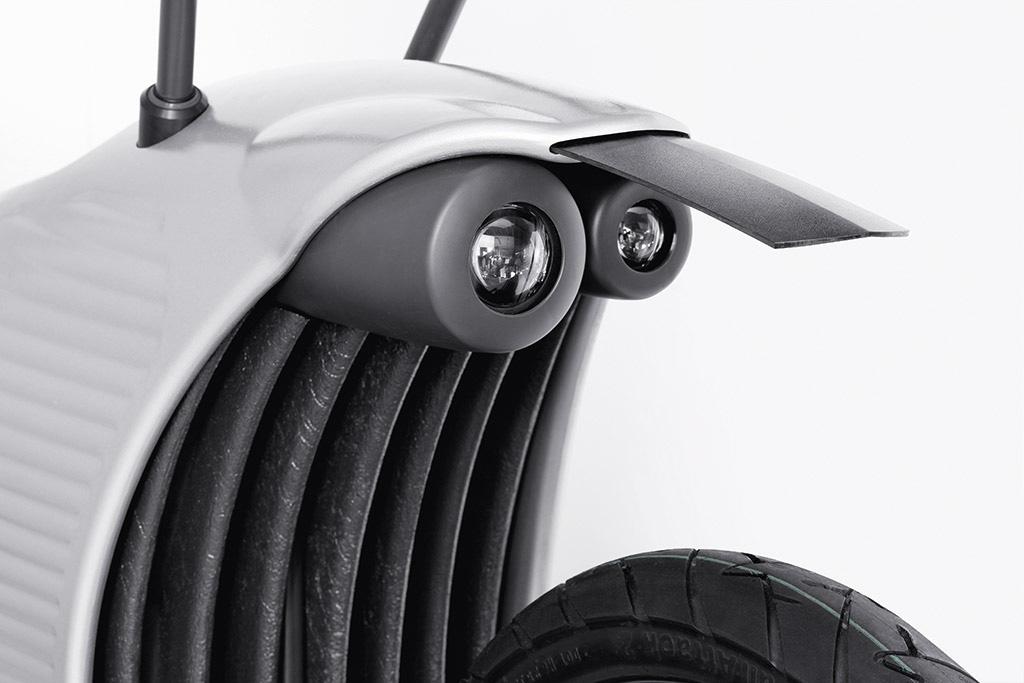Made in Austria by a company that’s apparently putting something in its employees’ water, the Johammer J1 is just the type of craziness I hope we see more of as we go down the road toward a future filled with innovative, electrically-driven vehicles.
Electric vehicles have flung the doors wide open when it comes to design possibilities, leading to mash-ups like the J1. Just one sighting of this electric two-wheeler is enough to bring a smile to any face.
Yep, it looks like a two-wheeled slug, or something out of the kid’s movie Epic. But once you get over the unusual appearance, which a company official said was called the “Biista” during development, a closer look at the tech under the skin reveals some impressive design execution.
First off, the basic details: The J1 is just over 7 feet long but has a reasonable 57-inch wheelbase, so it should be plenty stable at speed. Each bike packs an 8.3- or 12.7-kWh battery depending on the depth of your wallet, and Johammer says the power packs are good for 93 and 124 miles of range respectively. Motorvation comes from an air-cooled (and elaborately finned) 15hp electric motor located in the rear hub that can get the machine up to an electronically limited 74 mph on its single gear, so it’s comparable to many modern scooters already plying the streets. The bikes weigh in at 350 and 392 pounds respectively — heavy — but the weight is down low so handling dynamics should be comparable to that of a small motorcycle.
But after those now increasingly common powertrain details, the J1 departs convention. The front suspension dispenses with traditional forks in favor of a linkage system that recalls James Parker’s RADD suspension, which turned up in the exotic Bimota Tesi and the Yamaha GTS1000. Despite the scooter-ish output power, the J1 rolls on large motorcycle wheels stopped by petal-style disc brakes. Suspension components live inside a linkage box more akin to F1 than any motorcycle. This system is much more complex than a fork-and-swingarm setup, but it also imparts improved handling by separating the braking forces from the suspension action, lessening front-end dive under braking and improving suspension compliance during turning. Pretty trick stuff for a city machine.
The anthropomorphic look of the bike is clearly helped by a tall set of chopper-ish Z-bars topped by even taller rear-view mirrors that not only incorporate LED running lights and turn signals, but also feature built-in LCD screens showing speed, charge level, odo and more. While many motorcycle mirrors give you a great view of your elbows and not much else, the towering height of these mirrors will likely provide an unobstructed rear view of onlookers’ heads swiveling about to see what the heck just buzzed by.
Appropriately, twin bug-eye headlights illuminate the way forward while more rounded indicators out back take care of signaling duties. Standard scooter hand controls provide all throttle and braking control, and since there are no foot controls, pilots can place their feet in two positions including a tucked-in sporting position and a stretched-out touring pose. Johammer’s publicity photos show a somewhat masochistic seat featuring raised bumps; cover it in red material and it could be a big strawberry. Maybe it’s designed to give your tuchus an in-ride massage, we’ll have to get some actual seat time and report back.
Finally, the J1 is no concept machine, you can order one right now, but bring money. The base J1 costs just a few nickels under $32,000 at current exchange rates, and the extended range model adds $2,600 to that figure.
Some might scoff at the idea of riding around on something as purposefully out there as the Johammer J1, but then again, it wasn’t that long ago drivers snickered at getting behind the wheel of a hybrid, EV or tiny smart car. And if it works well, the J1 might be an ultimate city machine, despite the high cost. Let’s just hope they have the bugs worked out. Or in.




